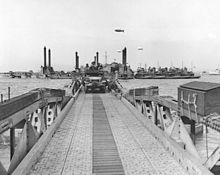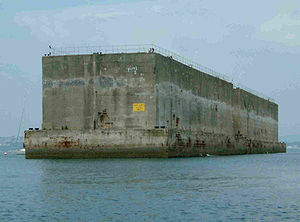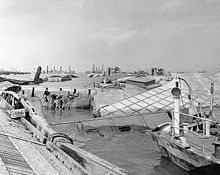- Mulberry harbour
-
A Mulberry harbour was a British type of temporary harbour developed in World War II to offload cargo on the beaches during the Allied invasion of Normandy.
Two prefabricated or artificial military harbours were taken across the English Channel from Britain with the invading army in sections and assembled off the coast of Normandy as part of the D-Day invasion of France in 1944.
Contents
Background
The Dieppe Raid of 1942 had shown that the Allies could not rely on being able to penetrate the Atlantic Wall to capture a port on the north French coast. Thus, the Mulberries were created to provide the port facilities necessary to offload the thousands of men and vehicles, and tons of supplies necessary to sustain Operation Overlord and the Battle of Normandy. The harbours were made up of all the elements one would expect of any harbour: breakwater, piers, roadways etc.
Development
The actual proposer of the idea of the Mulberry harbour is disputed, but among those who are known to have proposed something along these lines is Hugh Iorys Hughes, a Welsh civil engineer who submitted initial plans on the idea to the War Office, Professor J. D. Bernal, and Vice-Admiral John Hughes-Hallett.
At a meeting following the Dieppe Raid, Hughes-Hallett declared that if a port could not be captured, then one should be taken across the Channel. This was met with derision at the time, but in a subsequent meeting with Winston Churchill, the Prime Minister declared that in 1917[1] he had surmised a similar scenario using some Danish Islands and sinking old ships for a bridgehead for an invasion in World War I. The concept of Mulberry harbours began to take shape when Hughes-Hallett moved to be Naval Chief of Staff to the Overlord planners.
A trial of the three eventual competing designs was set up, with tests of deployment including floating the elements, in Garlieston, Wigtownshire. The designs were by Hugh Iorys Hughes who developed his "Hippo" piers and "Crocodile" bridge units on the Conwy Morfa, using 1,000 men to build the trial version; the Hamilton "Swiss Roll" which consisted of a floating roadway; and a system of flexible bridging units supported on floating pontoons designed by Major Allan Beckett, Royal Engineers. The tests revealed various problems (the "Swiss Roll" would only take a maximum of a 7 ton truck in the Atlantic swell). However the final choice of design was determined by a storm during which the "Swiss Roll" was washed away and the "Hippos" were undermined; Beckett's floating roadway (subsequently codenamed Whale) survived undamaged. Beckett's design was adopted and manufactured under the management of J. D. Bernal and Brigadier Bruce White, under the orders of Churchill.
The proposed harbours called for many huge caissons of various sorts to build breakwaters and piers and connecting structures to provide the roadways. The caissons were built at a number of locations, mainly existing ship building facilities or large beaches like Conwy Morfa around the British coast. The works were let out to commercial construction firms including Balfour Beatty, Costain, Nuttall, Henry Boot, Sir Robert McAlpine and Peter Lind & Company, who all still operate today, and Cubitts, Holloway Brothers, Mowlem and Taylor Woodrow, who all have since been absorbed into other businesses that are still operating.[2] On completion they were towed across the English Channel by tugs[3] to the Normandy coast at only 4.3 Knots (8 km/h or 5 mph), built, operated and maintained by the Corps of Royal Engineers, under the guidance of Reginald D. Gwyther, who received a CBE for his efforts.
Deployment
By 9 June, just 3 days after D-Day, two harbours codenamed Mulberry "A" and "B" were constructed at Omaha Beach and Arromanches, respectively. However, a large storm on 19 June destroyed the American harbour at Omaha, leaving only the British harbour which came to be known as Port Winston at Arromanches. While the harbour at Omaha was destroyed sooner than expected (due to it not being securely anchored to the sea bed, a result of incorrect and hasty assembly by the Americans), Port Winston saw heavy use for 8 months—despite being designed to last only 3 months. In the 10 months after D-Day, it was used to land over 2.5 million men, 500,000 vehicles, and 4 million tonnes of supplies providing much needed reinforcements in France.[4][5] In response to this longer than planned use the Phoenix breakwater was reinforced with the addition of extra specially strengthened caisson.[6]
The Royal Engineers built a complete Mulberry harbour out of 600,000 tons of concrete between 33 jetties, and had 10 miles (15 km) of floating roadways to land men and vehicles on the beach. Port Winston is commonly upheld as one of the best examples of military engineering. Its remains are still visible today from the beaches at Arromanches, and a section of it remains embedded in the sand in the Thames Estuary, accessible at low tide, about 1,000 m off the coast of the military base at Shoeburyness. A Phoenix unit known as The Far Mulberry sank off Pagham and lying at about 10 metres is an easily accessible scuba diving site.
Harbour elements and code names
Below are listed brief details of the major elements of the harbours together with their associated military code names.
Corn cob
"Corn cobs" were block ships that crossed the channel either under their own steam or that were towed and then scuttled to create sheltered water at the five landing beaches.. Once in position the "Corn Cobs" created "Gooseberries". The ships used for each beach were:
- Utah Beach (Gooseberry 1): Benjamin Contee, David O. Saylor, George S. Wasson, Matt W. Ransom,[7] West Cheswald, West Honaker, West Nohno, Willis A. Slater, Victory Sword and Vitruvius.
- Omaha Beach (Gooseberry 2): Artemas Ward,[7] Audacious, Baialoide, HMS Centurion, Courageous, Flight-Command, Galveston, George W. Childs, James W. Marshall, James Iredell,[7] Olambala, Potter, West Grama and Wilscox.
- Gold Beach (Gooseberry 3): Alynbank, Alghios Spyridon, Elswick Park, Flowergate, Giorgios P., Ingman, Innerton, Lynghaug, Modlin, Njegos, Parkhaven, Parklaan, Saltersgate, Sirehei, Vinlake and Winha.
- Juno Beach (Gooseberry 4): Belgique, Bendoran, Empire Bunting, Empire Flamingo, Empire Moorhen, Empire Waterhen, Formigny, Manchester Spinner, Mariposa, Panos and Vera Radcliffe.
- Sword Beach (Gooseberry 5): Becheville, Courbet, Dover Hill, HMS Durban, Empire Defiance, Empire Tamar, Empire Tana, Forbin and HNLMS Sumatra.
Gooseberry
The sheltered waters created by the Corn Cob block ships. Two of the "Gooseberries[8]" grew into "Mulberries", the artificial harbours.
Mulberry
A remnant of the Mulberry harbour built after the victory at Gold Beach on D-Day.
Mulberry was the code name for the artificial harbours. These were the "Gooseberries" which metamorphosed into fully fledged harbours. There were two harbours, Mulberry "A" and Mulberry "B". The "Mulberry" harbours consisted of a floating outer breakwater called "Bombardons", a static breakwater consisting of "Gooseberries" and reinforced concrete caissons called "Phoenix", floating piers code named "Whale" and pier heads code named "Spuds". These harbours were both of a similar size to Dover harbour.
Mulberry "A"
The Mulberry harbour assembled on Omaha beach at Saint-Laurent-sur-Mer was for use by the American invasion forces. Mulberry "A" was not securely anchored to the sea bed, resulting in such severe damage during the Channel storms of late June 1944 that it was considered to be irreparable and its further assembly ceased. It was commanded by Augustus Dayton Clark.
Mulberry "B"
Mulberry "B" was the harbour assembled on Gold Beach at Arromanches for use by the British and Canadian invasion forces. It lasted much longer than Mulberry "A".
Golden Arrow
"Arrow" was the code name for the port at Arromanches and "Golden" was a reference to the Gold Beach sector.
Bombardon
Large floating breakwaters fabricated in steel that were anchored outside the main breakwaters that consisted of Gooseberries (block ships) and Phoenix (concrete caissons). During the bad storms at the end of June 1944 these broke loose, and possibly caused more damage to the harbours than the storm itself. The design of the Bombardons was the responsibility of the Royal Navy while the Royal Engineers were responsible for the design of the rest of the Mulberry harbour equipment.
Phoenix
 A Whale floating roadway leading to a Spud pier at Mulberry A off Omaha Beach
A Whale floating roadway leading to a Spud pier at Mulberry A off Omaha Beach
Reinforced concrete caissons constructed by civil engineering contractors around the coast of Britain, collected and sunk at Dungeness, the Cant and Pagham. The engineers were unable to refloat the Phoenixes and US Navy Captain (later Rear Admiral) Edward Ellsberg, already well-known for quickly refloating scuttled ships at Massawa and Oran, was brought in to accomplish the task, though not without obtaining Churchill's intervention in taking the task away from the Royal Engineers and giving it to the Royal Navy. The Phoenixes, once refloated, were towed across the channel to form the "Mulberry" harbour breakwaters together with the "Gooseberry" block ships. Ellsberg rode one of the concrete caissons to Normandy; once there he helped unsnarl wrecked landing craft and vehicles on the beach.[9]
Whale
The dock piers were code named "Whale". These piers were the floating roadways that connected the "Spud" pier heads to the land. The roadways were made from torsionally flexible bridging units that had a span of 80 ft., mounted on pontoon units of either steel or concrete called "Beetles". After the war many of the "Whale" bridge spans from Arromanches were used to repair bombed bridges in France, Belgium and Holland. Such units are still visible as a bridge over the Meuse River in Vacherauville (Meuse), as a bridge over the Moselle River on road D56 between Cattenom and Kœnigsmacker (Moselle) and in Vierville-sur-Mer (Calvados) along road D517.
Beetle
Beetles were pontoons that supported the "Whale" piers. They were moored in position using wires attached to "Kite" anchors which were also designed by Allan Beckett. These anchors had such high holding power that very few could be recovered at the end of the War. The Navy was dismissive of Beckett's claims for his anchor's holding ability so Kite anchors were not used for mooring the Bombardons. The only known surviving Kite anchor is displayed in a private museum at Vierville-sur-Mer although a full size replica forms part of a memorial to Beckett in Arromanches.
Spud Piers
The pier heads or landing wharves at which ships were unloaded. Each of these consisted of a pontoon with four legs that rested on the sea bed to anchor the pontoon, yet allowed it to float up and down freely with the tide.
German equivalent of Mulberry
In the period between postponement and cancellation of Operation Sea Lion, the invasion of the UK, Germany developed some prototype prefabricated jetties with a similar purpose in mind.[10] These could be seen in Alderney, until they were demolished in 1978.[10] The remaining foundations for the Alderney jetty formed an obstruction to the commercial quay extension project carried out in 2008/9.
Daily Telegraph crosswords
"Mulberry" and the names of all the beaches were words appearing in the Daily Telegraph crossword puzzle in the month prior to the invasion. The crossword compilers, Melville Jones[11] and Leonard Dawe were questioned by MI5 who determined the appearance of the words was innocent, but after the turn of the century, a former student identified that Dawe frequently requested words from his students, many of whom were children in the same area as US military personnel.[12]
Deception
Some troops from the American Ghost Army went to Normandy two weeks after D-Day to simulate a fake Mulberry harbour. The deception was created in such a way that at night its lights drew German gunfire away from the real Mulberries.
See also
References
- ^ Mulberry harbours
- ^ Guy Hartup, Code Name Mulberry: The Planning Building and Operation of the Normandy Harbours, Page 94
- ^ Thames Tugs. Mulberry Harbour: British, French and Dutch tugs. Retrieved on 20 April, 2009.
- ^ staff. Mulberry Encyclopaedia Britannica's Guide to Normandy 1944
- ^ Chris Trueman The Mulberry Harbour www.historylearningsite.co.uk. Accessed 25 April 2008
- ^ Hughes, Michael; Momber, Gary (2000). "The Mulberry Harbour Remains". In Allen, Michael J; Gardiner, Julie. Our Changing Coast a survey of the intertidal archaeology of Langstone Harbour Hampshire. York: Council for British Archaeology. pp. 127–128. ISBN 1902771141.
- ^ a b c Morton, Jr, Wilbur D. The Journey Continues: The World War II Home Front. p. 111.
- ^ Churchill, Winston Spencer (1951). The Second World War: Closing the Ring. Houghton Mifflin Company, Boston. pp. 642.
- ^ Ellsberg, Edward (1960). The Far Shore. New York: Dodd, Mead.
- ^ a b Alderney at War. Brian Bonnard. 1993. ISBN 0-7509-0343-0. pp106–108. Alan Sutton Publishing Limited.
- ^ "D-Day crosswords are still a few clues short of a solution". The Daily Telegraph. 6 February 2009. http://www.telegraph.co.uk/news/uknews/1460892/D-Day-crosswords-are-still-a-few-clues-short-of-a-solution.html. Retrieved 15 januari 2011.
- ^ "The Crossword Panic of 1944" (html). Historic-UK.com. http://www.historic-uk.com/HistoryUK/England-History/Crossword.htm. Retrieved 2009-09-27.
Further reading
- J. Evans, R. Walter, E. Palmer, 'A Harbour Goes to War: The Story of Mulberry and the Men Who Made It Happen'. Publisher - South Machars Historical Society (2000), ISBN 1-873547-30-7
- Stanford, Alfred B., Force Mulberry: The Planning and Installation of the Artificial Harbor of U.S. Normandy Beaches in World War II, New York: William Morrow & Co., 1951 - details the design, assembly and construction of the American artificial harbour (Mulberry A) at Omaha Beach. Much of this book deals with the 108th Seabees, the unit which was responsible for construction of the Mulberry. Stanford was deputy commander of harbour during the invasion.
- Hartcup, Guy, Code Name Mulberry: The planning, building and operation of the Normandy harbours, David & Charles (Publishers) Ltd, 1977 - This book covers the background to Mulberry harbours as part of Operation Overlord, the prototypes, the testing and development, the building (including contributions of suppliers) plus the installation and running. A book that covers the whole project very well.
- Institution of Civil Engineers, The Civil Engineer at War, vol 2. Docks and Harbours, 1959 - This is a collection of papers read at a symposium. They include a number of detailed plans and calculations contributing towards the final designs. Included are estimations of extracting power from waves by floating and stationary breakwaters.
External links
- Peter Lind & Company
- The Mulberry Harbours
- Contemporary report by SHAEF
- Google Maps satellite view
- A wartime aerial view of part of the Mulberry Harbour at Arromanches
- Franklin D. Roosevelt Library Records regarding Construction and Operation of Mulberry B for the Normandy Invasion, Dwight D. Eisenhower Presidential Library
- "A Harbour Built From Scratch," Invention and Technology, Vol. 20, Issue 1
- Papers of Alfred B. Stanford, deputy naval commander of Mulberry A, Dwight D. Eisenhower Presidential Library
- Thames Tugs. Mulberry Harbour
- U.S. Navy Department Library Miracle harbor Set of photographs giving an excellent overview of the whole.
- An overview of the harbour design and performance using modern design philosophy
Categories:- Operation Overlord
- Coastal construction
Wikimedia Foundation. 2010.




